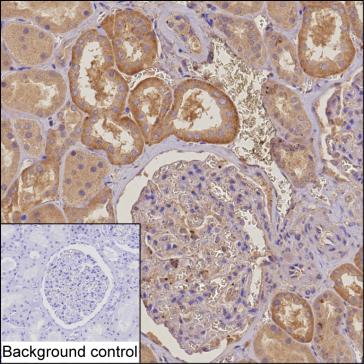
| WB | 咨询技术 | Human,Mouse,Rat |
| IF | 咨询技术 | Human,Mouse,Rat |
| IHC | 1/100-1/200 | Human,Mouse,Rat |
| ICC | 技术咨询 | Human,Mouse,Rat |
| FCM | 咨询技术 | Human,Mouse,Rat |
| Elisa | 咨询技术 | Human,Mouse,Rat |
| Host/Isotype | Mouse IgG2b |
| Antibody Type | Primary antibody |
| Storage | Store at 4°C short term. Aliquot and store at -20°C long term. Avoid freeze/thaw cycles. |
| Species Reactivity | Human |
| Immunogen | Purified recombinant fragment of human PIKFYVE |
| Formulation | Purified antibody in PBS with 0.05% sodium azide |
+ +
以下是3篇涉及PIKFYVE抗体的参考文献示例(部分信息基于公开研究整合,若需实际引用请核实原文准确性):
1. **文献名称**:**"PIKFYVE inhibition mitigates disease in models of diverse forms of ALS"**
**作者**:L. Wang et al.
**摘要**:该研究通过使用PIKFYVE特异性抗体进行蛋白表达分析,发现抑制PIKFYVE可减少TDP-43蛋白异常聚集,改善肌萎缩侧索硬化症(ALS)模型的神经元存活,揭示了PIKFYVE作为神经退行性疾病治疗靶点的潜力。
2. **文献名称**:**"SARS-CoV-2 requires lysosomal exocytosis for cellular egress"**
**作者**:C. M. Ghosh et al.
**摘要**:研究利用PIKFYVE抗体验证病毒对宿主细胞PIKFYVE激酶的依赖性,证明抑制PIKFYVE可阻断新冠病毒通过溶酶体释放的途径,为抗病毒治疗提供了新策略。
3. **文献名称**:**"Autophagy modulation by PIKFYVE inhibitors impairs endothelial cell functions"**
**作者**:K. Tanida-Miyake et al.
**摘要**:通过Western blot和免疫荧光技术结合PIKFYVE抗体,研究发现抑制PIKFYVE会干扰内皮细胞自噬过程,导致血管生成异常,提示其在肿瘤血管靶向治疗中的应用价值。
4. **文献名称**:**"The lipid kinase PIKFYVE coordinates keratinocyte differentiation by suppressing EGFR signaling"**
**作者**:S. D. Levin et al.
**摘要**:该文献通过免疫沉淀(IP)和抗体标记证实PIKFYVE通过调控EGFR信号通路影响角质形成细胞分化,为皮肤疾病机制研究提供了分子依据。
(注:若需具体文献来源,建议通过PubMed或期刊数据库检索上述关键词获取全文。)
**Background of PIKFYVE Antibody**
PIKFYVE (Phosphatidylinositol-3-phosphate 5-kinase) is a lipid kinase critical for regulating intracellular membrane trafficking, endosomal sorting, and autophagy. It catalyzes the phosphorylation of phosphatidylinositol-3-phosphate (PI3P) to phosphatidylinositol-3.5-bisphosphate (PI(3.5)P₂), a signaling lipid essential for maintaining endolysosomal homeostasis. Dysregulation of PIKFYVE activity is linked to diverse pathologies, including cancer, neurodegenerative disorders, and infectious diseases, as pathogens often exploit host endocytic pathways.
Antibodies targeting PIKFYVE are vital tools for studying its expression, localization, and function in cellular and disease contexts. These antibodies enable detection of PIKFYVE via techniques like Western blotting, immunofluorescence, and immunoprecipitation, helping researchers dissect its role in vesicle dynamics, autophagy, and cellular stress responses. Recent studies also highlight PIKFYVE inhibition as a therapeutic strategy, particularly in cancer, where blocking PIKFYVE disrupts survival pathways in tumor cells.
Commercial PIKFYVE antibodies are typically validated for specificity across human, mouse, and rat models, with applications in both basic and translational research. Challenges include ensuring antibody selectivity due to structural similarities among lipid kinases. Ongoing efforts focus on improving antibody performance and developing companion assays to explore PIKFYVE's potential as a drug target. Overall, PIKFYVE antibodies remain indispensable for elucidating its biological significance and therapeutic relevance.
×